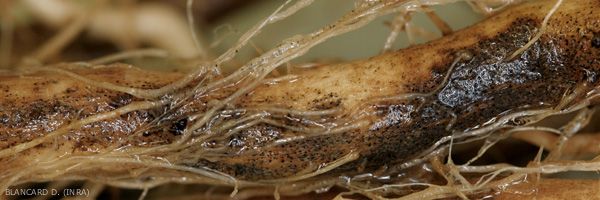
(Wallr.) S. Hughes, (1958)
- Classification: Fungi, Basidiomycota, Lichinomycetes, Sordariomycetidae, Incertae_sedis_, Glomerellaceae
- téléomorphe : Glomerella
- English name: anthracnose, black dot root rot
Colletotrichum coccodes is very common in all types of crops , whether in open fields or under cover, in soil as well as in soil. Industrial tomato producers fear above all its attacks on fruits which appear more on mature and overripe fruits; we speak in this case of "symptoms of anthracnose". This condition is considered to be the most serious threat to mature fruit in industrial tomato crops in several production areas of the United States. In these regions and in the absence of protection methods, the proportions of rotten fruit can reach 70%. Frequently observed in field crops in France , it is especially feared in crops intended for processing.
Root damage caused by this fungus is often underestimated. Long considered a secondary pathogen and associated with attacks by Pyrenochaeta lycopersici in particular, it must now be considered as a pathogenic fungus of tomatoes, calling into question the cultivation of the latter, in particular in intensive soil production systems. Thus, it causes more or less consequent damage, in soil as in soilless culture. It is emerging on KNVF type rootstocks used as an alternative to methyl bromide. This is particularly the case in Italy and France , where it contributes to questioning this cultivation option. In our country, it acts in complex with other soil-borne pests attacking the roots, such as Rhizoctonia solani , Phytophthora nicotianae , several species of Meloidogyne and Globodera tabacum .
Colletotrichum coccodes has two synonymies : C. atramentarium (Berk. & Br.) Taube and C. phomoides (Sacc.) Chester. Very cosmopolitan and polyphagous, it is recorded in many tomato and potato-producing countries, on all continents.
isolates C. coccodes appear to exhibit pathogenic powers, growth rates, sclerotia sizes quite variable. They mainly cause damage to the roots and fruits of the tomato. Other species Colletotrichum are reported on fruits, notably C. gloeosporioides (Penz.) Penz. & Sacc. in Penz. and C. dematium (Pers.) Grove.





